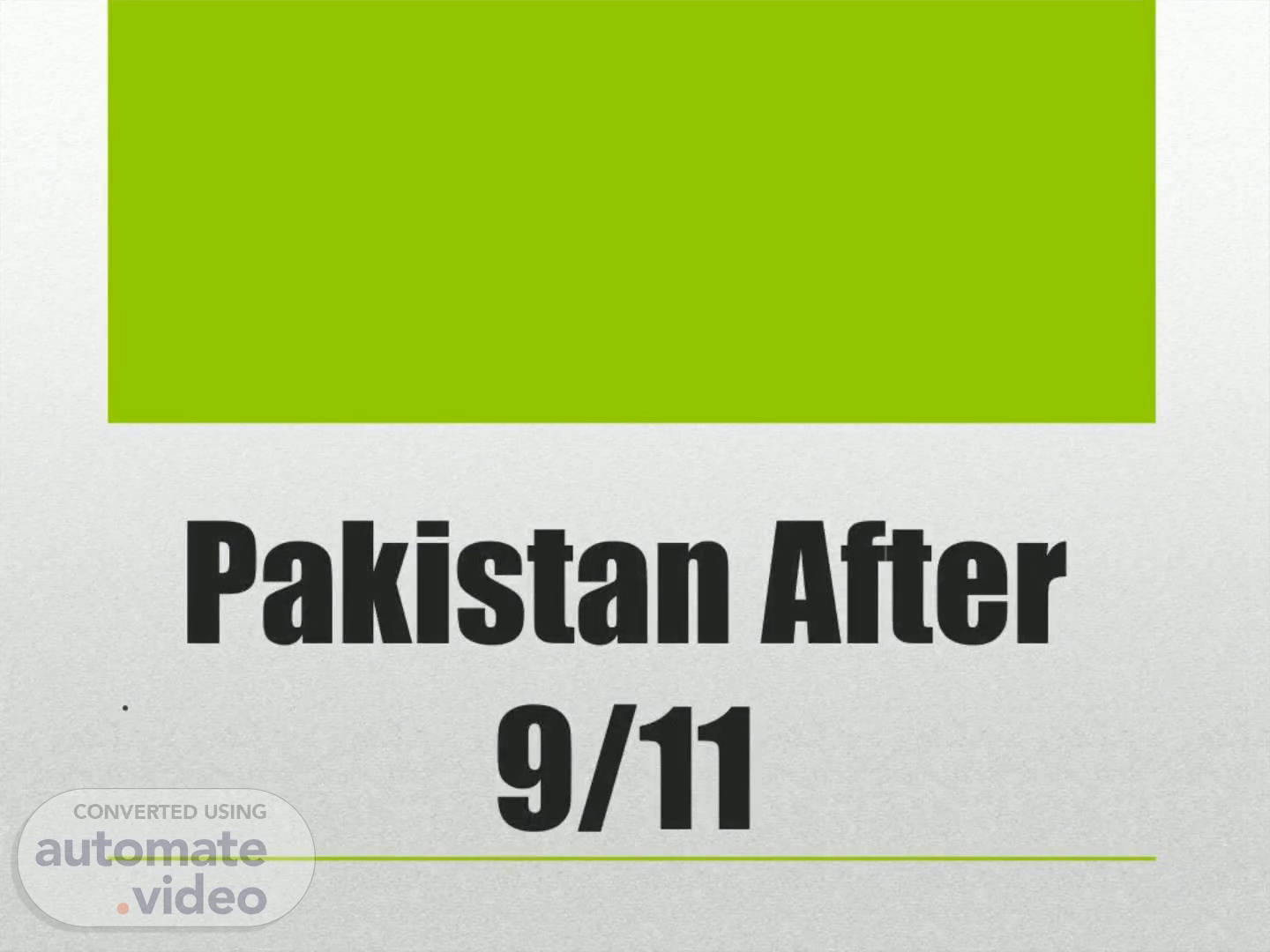
Untitled Presentation
Scene 1 (0s)
Pakistan After 9/11.
Scene 2 (6s)
9/11 11 September, 2001. America faced a big terrorist attack. Four airplanes were hijacked by 19 men. Two of the planes were crashed into the twin towers of the World trade Centre in New York. A third plane, crashed into the Pentagon, headquarters of United States Department of Defense. The fourth plane was initially steered towards Washington D.C, but crashed into a field near Pennsylvania..
Scene 3 (25s)
US RESPONSE US used to support the Taliban. But, after 9/11 US turned against them. The Bush administration announced a war on terrorism. This war was to eradicate Al-Qaida and Osama bin Laden. The American troops invaded Afghanistan and Iran. Pakistan agreed to help US in war against terror..
Scene 4 (42s)
Pakistan agreed to help US: Pakistan agreed to help US in War on Terror. Pakistan became a frontline ally with US against terrorism. Musharraf allowed his country's airspace, Intelligence etc. to be used for launching attacks on Afghanistan. Pakistan also made its road network available to US and NATO forces to transport weapons and other supplies to Afghanistan..
Scene 5 (59s)
Why Pakistan agreed to help USP General Pervaiz Musharraf was one of the first leaders to receive clarion call from U.S. to support them. President Bush had said, "You are with us or against us." Pakistan had been warned by US Assistant Secretary of State Richard Armitage to either support the US or be ready to be bombed and return back to the Stone Age. Musharraf agreed to help them. As a result Pakistan got stuck in the Global War on Terror. O O.
Scene 7 (1m 27s)
US TROOPS ATTACK SALALA CHECK POST: Pakistan provided all possible help to the US troops for war on terror. Land route, military, air bases, intelligence were provided. But it stopped supporting when NATO helicopters killed at least 24 security personnel and injured 12 soldiers on a Pakistani check post in Salala, which is located in the Tehsil Bayzai area of Mohmand Agency on the Pak-Afghan border. 4.
Scene 8 (1m 46s)
CHANGE IN PAK-AFGHAN RELATIONS: A drastic change came in Pak-Afghan relations policies. US forces attacked Afghanistan in October, 2001. Pakistan quickly broke its ties with Taliban. Since then Pakistan has faced a lot of loss in the form of precious lives, property and the cost of waging the war and indirectly through loss of revenue, investment and business. 8.
Scene 9 (2m 3s)
Increase in terrorism: Before 9/11, there was only a single recorded suicide attack in Pakistan's history. But post 9/11, hundreds of such attacks took place. The US might have had one 9/11 but Pakistan had dozens. Attacks on religious places, educational institutions, markets and parks. Attacks on police officers, Pakistan Army soldiers and military bases..
Scene 10 (2m 22s)
Loss of innocent lives: Pakistan faced about 11,975 terrorist attack from 2006-2011. • In these attacks many innocent lives were lost. According to SATP, in these attacks more than 62656 lives were lost, which includes 21978 citizens and 6858 security force officers..
Scene 11 (2m 37s)
Effect on tourism: Tourism in Pakistan has received a great setback due to the war on terror. Islamabad virtually became no-go city in the aftermath of the 9/11 attacks. Many Northern areas that once attracted the tourists now are declared as dangerous. More than a hundred local guest houses have been shut down in the Northern Areas due to the frontline activism in the war on terror..
Scene 12 (2m 56s)
Effect on economy: War on terror had a devastating effect on Pakistan 's economy as well. People are doubtful about investing in countries where rate of terrorism is high. This is why one-third of factories in Pakistan were closed down during 2008 and 2009. GDP growth rate went down from 8.40 percent in 2004-05 to 5.80 percent in 2007-08. In 2009-10 it had reduced to 4.1 percent. War on terror cost Pakistan over $80 billion..
Scene 13 (3m 19s)
EFFECT OF "WAR ON TERROR" ON PAKISTANI PEOPLE.
Scene 15 (3m 30s)
INDIAN INTERFERENCE AND BALOCHISTAN UPRISING.
Scene 16 (3m 36s)
Pakistan is a "victim" of Indian- sponsored terrorism. On 3 March 2016, a RAW agent, Kulbhushan Jadhav was captured in Balochistan. He confessed during interrogation that RAW is involved in prevailing terrorist activities in Pakistan. India is also behind the Insurgency in Balochistan. Many terrorist groups are funded by Indian government. India is acting as a hindrance in peace of Pakistan. BRP BLA Indian Terrorism in Balochistan.
Scene 17 (3m 54s)
PAKISTAN'S ROLE IN ERADICATING TERRORISM.
Scene 19 (4m 5s)
Pakistan army is committed in eradicating terrorism from this country. Following are some major operations conducted by Pak Army: Operation Rah-i-Haq-I in Swat valley and Shangla district (2007) Operation Rah-i-Haq-II in Swat valley and Shangla (2()()8) Operation Sirat-i-Mustaqeem in Khyber Agency (2008) Operation Sherdil jointly launched with Frontier Coms in Bajaur Agency (2008) Operation Rah-i-Haq-III in Swat valley and Shangla (2009) Operation Black Thunderstorm in Buner, Lower Dir and Shangla district (2009) Operation Brekhna in Mohmand Agency (2009) Operation Rah-i-Rast, commonly known as Swat Operation, (2009) Operation Rah-i-Nijat in South Waziristan (2009) Operation Zarb-e-Azab Operation Koh-e-Sufaid (July 2011) Operation Zarb-e-Azb (2013).
Scene 20 (4m 33s)
Operation Zarb-e-Azb and Operation Radd-ul-Fasaad are going on. Pak army has successfully cleared a lot of area in FATA from Taliban. A lot of work is going on in Waziristan and policies are being made for the development of Pakistan and its national security. Many tourist sites have been opened and again foreign countries have started sending its people for investment, tourism etc..
Scene 21 (4m 52s)
noK >luetll.